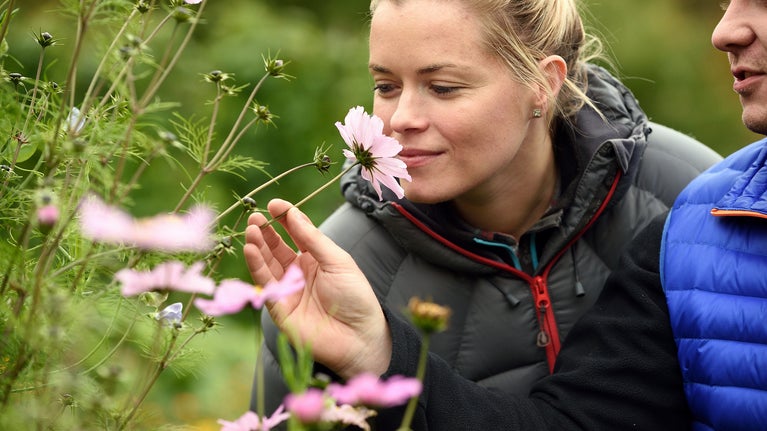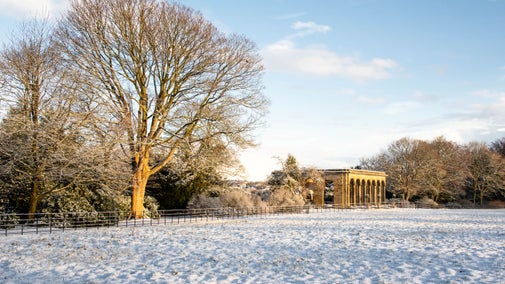
Discover more at Gibside
Find out when Gibside is open, how to get here, the things to see and do and more.

Coal baron George Bowes designed the Gibside estate to impress his wealthy guests. On his death, his daughter Mary Eleanor inherited a vast fortune but Gibside’s fortunes fell when she was tricked into marrying her second husband, ‘Stoney’ Bowes. Discover the history of the Gibside estate.
On inheriting Gibside in 1722, George Bowes (1701–1760) quickly took to his role as estate and coal-mine owner with enthusiasm. The Bowes family were one of the most ancient families of County Durham and George cemented relationships with local coal merchants and ensured a deal that would benefit them all.
Mary Eleanor (1749–1800), born to George Bowes’s second wife, was his only child and became one of the most talked-about and sought-after ladies in London’s high society. Sadly, her husbands inflicted tragedy and pain rather than happiness. However, her life was purposeful in more ways than one.
When George Bowes inherited Gibside, the vision was always to impress. So, it’s perhaps no suprise that he commissioned a 43m (141ft) high tower on his newly landscaped grounds.
When completed in the mid-18th century, the Column to Liberty could be seen for many miles through the Derwent and Tyne valleys.
At the top, a female figure – once gilded – representing Liberty holds the Staff of Maintenance and Cap of Liberty. It was a proclamation of George Bowes’ political support of the Whig Party.
Although there are no records to prove that Daniel Garrett was the Column's architect, as Daniel worked extensively on other buildings at Gibside, he was most likely the top choice for the job.
Framed by trees at the end of the half mile-long Avenue and designed as a mausoleum by renowned Palladian architect James Paine, the chapel forms the centrepiece of Bowes’ Georgian landscape garden.
Work began on the chapel in 1760, a few months before George Bowes died. His second wife, Mary, completed the exterior in 1769 but it wasn’t until the early 19th century that final touches to the interior were finished. The building has been in almost continual use since.
Sermons were delivered from the top of the pulpit with readings given from the middle, and a clerk sitting below. The congregation were traditionally seated according to their role and status on the estate. The family box was reserved for the Bowes-Lyons – and underfloor heating made this area particularly comfortable.
The dome features a hole, where it's possible that a candelabra may have been lowered and raised using a pulley.
Mary Eleanor Bowes (1749–1800), born to George Bowes’s second wife, was his only child and became one of the most talked-about and sought-after ladies in London’s high society.
She was doted on by her father who, until his death, employed tutors for her in languages, the arts and writing, and ensured she received the sort of education usually only bestowed on sons at that time.
With an inherited fortune of between £80 million and £150 million in today’s money, Mary Eleanor was said to be the wealthiest heiress in Georgian England.
Built between 1772-74, the orangery is Mary Eleanor Bowes’ only original contribution to the buildings of Gibside.
Once described by a contemporary 'as the most intelligent female botanist of the age', she commissioned plant collector William Paterson to explore South Africa in search of rare and new species.
The orangery would have been home to this brilliant and diverse collection of unusual plants.
Sadly, the architect of the orangery is unknown, although some of its features point to the influence of James Paine, who designed the chapel.
The original layout of this large space was into three rooms to the north, known as ’garden rooms’. There was also one large room to the south, purely for the display of plants.
The large south-west facing windows provided a huge amount of light and a heating system would have kept exotic plants warm during the winter.
Evidence suggests that Mary Eleanor used the north-east room as a writing room, and it’s likely given her social status (when widowed) that she would have entertained guests here.

Years later, Gibside fell into decline under the watch of Mary Eleanor’s second and cruel husband, Andrew 'Stoney' Robinson Bowes (1747–1810).
He ran up debts, sold off much of the estate’s timber and neglected the buildings, all the while keeping Mary Eleanor a prisoner in the Hall and forbidding her to visit her beloved greenhouses. Towards the end of her life Mary Eleanor revealed that, following their marriage in 1777, Stoney ‘began to treat me with the upmost indignity’.
They divorced but several years passed before it was granted, during which time Mary Eleanor suffered much hardship and had her name slurred in the press by court journalists salivating over every scandalous statement. In November 1786, Stoney Bowes abducted his estranged wife before finally being captured and arrested.
Part of Mary Eleanor’s legacy is that her divorce case paved the way for reform of English divorce and custody laws.
A decade of abandonment and destruction during the Stoney Bowes terror years left the pleasure grounds overgrown and Gibside’s buildings in a poor state. But Gibside’s fortunes were about to turn.
Mary Eleanor's son John Bowes, the 10th Earl of Strathmore (1769–1820), recorded accounts for 1790 showing that the young landlord ordered 17,500 young oak trees, 5,000 elm seedlings, three dwarf peaches (perhaps for the new peach house he planned) and several hundred other saplings.
The figure at the top of the Column to Liberty was re-gilded, shutters were put up in his mother’s beloved Green House and the Banqueting House interior was whitewashed. John Bowes also constructed farm buildings and a new hothouse, and substantially restructured Gibside Hall.
The 10th Earl’s short life was marred by the early death of his love interest, Sarah, Lady Tyrconnell of Seaton Delaval Hall, Northumberland (now also looked after by the National Trust).
The day before he died in 1820, he married his housemaid mistress, Mary Milner. Their illegitimate son, also named John Bowes (1811–1885), was nine at the time; he didn’t inherit the Strathmore title, but he did become landlord to the Bowes family's estates in England.
Though he lived in France, John Bowes maintained his interest in Gibside, making small repairs and, it is presumed, planting the trees on the Avenue (the oldest of which dates to this period).
In fact, a lot of new trees were planted across the estate at the time, including deodar cedar and monkey puzzle. But estate records reveal that the ‘remaining household furniture, oil paintings, horses, cattle, poultry, chariot, carts, harnesses, plants, implements &.c.’ were sold at auction in spring 1874.
Gibside’s demise continued through the 20th century as more of the estate was broken up and sold. The elegant urns that once graced the balustrade of Mary Eleanor’s Green House were removed and resited at the Bowes-Lyons' principal seat at Glamis Castle.
One by one, most buildings were deliberately dismantled or allowed to decay; the north-east corner of Gibside Hall was blown up. The Forestry Commission leased the woods and sold some of the last remaining old broadleaved trees dating from the reign of King George II, replacing them with commercial conifers.
After taking on the upkeep of the Chapel, the National Trust became responsible for the Avenue and later the ruined Hall and Green House. It wasn’t until the mid-1980s that visitors began to trickle into the grounds. At that time, most of the paths were still overgrown but things are very different today.
By the early 1990s, the idea of reassembling the fragmented grounds as one unified estate became a real possibility. Acquisitions continued into the 21st century as the Trust took on Cut Thorn Farm and the Stables.
Today, we continue to manage the estate and continue to tell George and Mary Eleanor Bowes's story.
Mary Eleanor’s grandson, John Bowes, founded the Bowes Museum in 1811, a Grade I-listed French-style château in the picturesque market town of Barnard Castle.
It’s one of the most important museums outside London and houses paintings by El Greco and Goya – the only works by these artists outside the national collections in London and Edinburgh.
Furniture, ceramics and sculpture are also well represented, and the collections have received Designated status from the government in recognition of their significance.
Among the treasures is a botanical cabinet, thought to have been commissioned by Mary Eleanor Bowes around 1780 to house her exotic plant collections.
The museum isn’t part of the National Trust and entrance fees will apply, so please check the Bowes Museum's website before visiting.

Find out when Gibside is open, how to get here, the things to see and do and more.
Discover nature and historic ruins set in a Georgian landscape garden while you explore miles of peaceful walking trails. Or dive into seasonal events that celebrate history, health, wildlife, and gardening.

This route meanders around the landscape garden created by George Bowes and now in our care. You'll see grand historic features that play a huge part in Gibside's story and garden design.

Interested in volunteering at Gibside? Here's all you need to know about helping us care for this special place, and how to apply if you'd like to get involved.

Gibside is the perfect place to bring a group of young people from schools, universities, Brownies and Scouts. Spark their creativity, build confidence, develop problem solving skills and enjoy nature.

Learn about people from the past, discover remarkable works of art and brush up on your knowledge of architecture and gardens.
